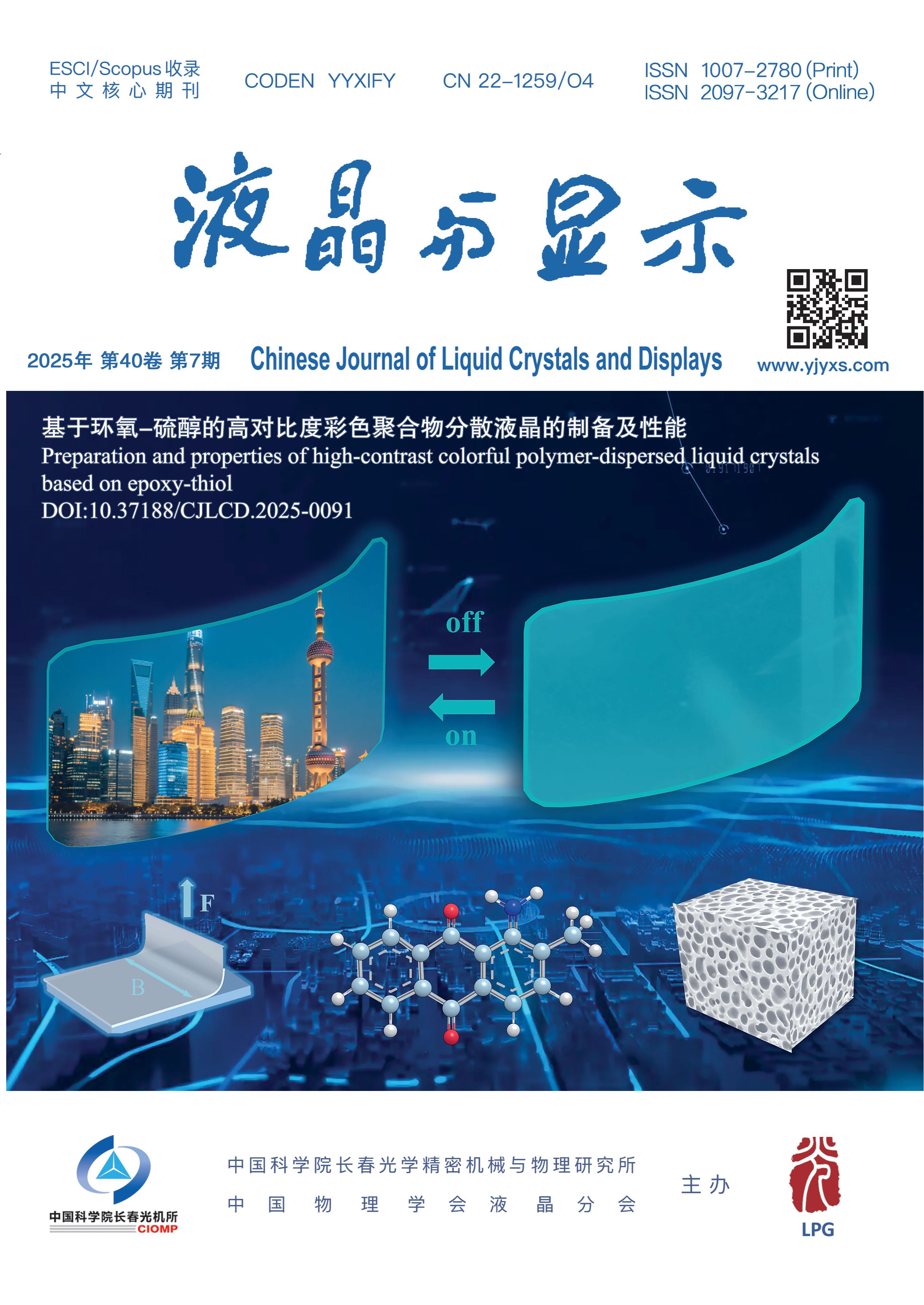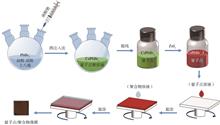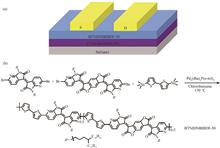
All-inorganic CsPbX3 (X = Cl, Br, I) perovskite quantum dots have excellent luminescence properties and are a new kind of display material and laser gain medium with great application potential. In this paper, CsPbBr1.2I1.8 red quantum dots with luminescence peak at 640 nm were prepared and the CsPbBr1.2I1.8 quantum dot films were coated with three kinds of polymers with different functional groups: polymethyl methacrylate (PMMA), polyiso-butyl methacrylate (PIBMA) and polystyrene (PS). The amplified spontaneous emission performance of CsPbBr1.2I1.8/PMMA, CsPbBr1.2I1.8/PIBMA and CsPbBr1.2I1.8/PS composite films were studied. The results show that the polymer passivation improves the water stability of quantum dot films. Moreover, the C? O in PMMA and PIBMA passivates the uncoordinated Pb2+ on the surface of quantum dots, enhancing the photoluminescence intensity of QD films. Furthermore, the amplified spontaneous emission threshold of CsPbBr1.2I1.8/PIBMA film is as low as 81 μJ·cm-2 under nanosecond laser pumping at 532 nm. The stability is improved, demonstrating its potential as a novel gain medium.
A three-component donor-acceptor conjugated polymer (BTNIDNBIBDF-50) film based on dithiophene-aza-isoindigo-bis(2-oxodihydro-7-azaindol-3-ylidene)benzodifurandione was investigated for the sensing characteristics of nitrogen dioxide gas. The effect of semiconductor concentration on the sensitivity of nitrogen dioxide was studied by controlling the morphology of semiconductor film. The polymer semiconductor BTNIDNBIBDF-50 showed the best sensing performance for NO2 gas at a concentration of 2 mg/mL, and the sensitivity for NO2 gas at 10×10-6 (volum fraction) was 121.44%. The experimental results show that bipolar semiconductor polymer BTNIDNBIBDF-50 shows ambipolar charge transport characteristics. Reducing the concentration of the polymer semiconductor will lead to obvious holes on the surface of the film and improve the sensitivity of the sensor to NO2 gas. However, the excessive porosity can cause the change in gas desorption rate to be greater than the change in adsorption rate, leading to the decrease of sensor sensitivity.
The surface coverage of micro-nano structure seriously affects the spectroscopic conformity of the surface-enhanced Raman scattering (SERS) substrate. In the paper, the influence of the surface coverage on the spectrum is studied, and a method is proposed to eliminate the influence of surface coverage. First, the SERS substrate was prepared by using the lyotropic liquid crystal soft template and the relationship between the surface coverage and Raman spectral intensity is analyzed to obtain a formula. Then, based on the this formula, all measured spectral intensities are unified to the standard surface coverage, which is defined with the measured average spectral intensity corresponded surface coverage, thus, the influence of the surface coverage on the spectral intensity is elimanated. Finally, the effectiveness of the proposed method is verified with different SERS substrates and different test spot sizes on the same substrate. The fitting and experimental results show that the spectral intensity changes as an exponential function of the surface coverage, the coefficients of variation are reduced to about 6% for different substrates, the spectroscopic conformities of the substrate are improved more than twice or so for different measured spots, and the coefficients of variation linearly decrease with the spots increase. In a word, the proposed method can improve the spectroscopic conformity of the SERS substrate significantly, the quantitative and reliable detection of various material components will be realized. This work may greatly promote the application of the SERS substrate in multiple detection fields.
This paper reviews optical compensation schemes for the elimination of off-axis light leakage in an in-plane-switching LCD. The dark-state light leakage of visible light is studied by using simulation software. Firstly, the method of optical compensation using biaxial membrane is summarized. The performance of the compensation methods that use two biaxial films is much better than that of the compensation methods using one biaxial film. Then, six methods of optical compensation using uniaxial films were investigated, and the methods of off-axis light leakage close to zero were obtained. Finally, we calculated the angle and wavelength dependence of the eight compensation methods. Optical compensation to improve the wide-viewing-angle characteristics is essential in a liquid crystal display (LCD).
Polarizer is an important optical device. Generally, the polarization direction of polarizer used in laboratory is unknown. In order to obtain the accurate polarization direction of the polarizer, a method for measuring the polarization direction of the polarizer based on Brewster's law is proposed. The polarizer with the measured polarization direction is placed in the optical path of the liquid crystal photoelectric test system, and the variation of the light transmission with the angle between the polarization direction of the polarizer and the front friction orientation direction of the liquid crystal cell is measured. The experimental results show that when the included angle between the polarization direction of the polarizer and the front friction orientation direction of the liquid crystal cell is 45°?, the light transmission reaches the maximum. At this angle, the change of the light transmission with the applied voltage and time is tested and analyzed theoretically. It is verified that the polarization direction of the polarizer can be accurately measured based on Brewster's law. Then a physical experimental optical path is built to measure the polarization direction of the unknown polarizer, which is verified by the known photoelectric test system, so that the polarizer can be better applied in the field where the polarization direction needs to be accurately measured.
To calculate the modes in liquid crystal optical waveguides, we derive the dispersion equation of transverse electric (TE) mode in the asymmetrical anchoring in-plane switching nematic liquid crystal (IPS-NLC) slab optical waveguide by using the analytical thinking of the WKB method. The mode is solved and compared with the results obtained from the traditional dispersion equation. The results show that the effective refractive index of each mode obtained by the traditional dispersion equation is always greater than that calculated by our equation. The deviation between the effective refractive index is not only related to the applied voltage but also becomes more severe with the increase of the mode order. In the current example, the maximum deviations corresponding to the fundamental, first-order, and second-order modes account for 7.8%, 17.8%, and 26.3% of the liquid crystal’s birefringence, respectively. This result indicates that the gradient characteristic of the liquid crystal’s director has a non-negligible effect on calculating the effective refractive index. Consequently, the dispersion equation proposed by us can analyze the modes in the IPS-NLC optical waveguide more effectively than the traditional dispersion equation. Finally, the accuracy of the dispersion equation presented in this study is verified by comparing ours with the existing numerical results.
Based on the theory of cohesive force model, this paper proposes a flexible screen adhesion method, which overcomes the problem that the traditional screen adhesion technology can only be used for flat screen adhesion but not flexible material adhesion. A simulation model is established to simulate the bonding process and analyze the stress variation of the process. The influence of different down loading and rotation speed on the simulation results is discussed. Based on the cohesion model theory, a kind of fitting method for flexible screen can be established. The influence of the change of the down load on the stress is linear. The change of rotation speed has little effect on stress.
Liquid crystal variable retarder (LCVR) has become a new research area for space-based optical instruments because of its fast modulation speed, light weight and no moving parts.etc. Nevertheless, the molecule in LCVR is a type of liquid crystal polymer, its space adaptability needs to be verified. Because we cannot simulate the space environment absolutely in the ground, it is necessary to develop a LCVR experimental device to study the electro-optic performance of LCVR in space. In this paper, the stability of a LCVR measurement system is analyzed, and an electronic measurement scheme for LCVR??’?s retardation-voltage curve is designed. Firstly, a zero-calibration method is proposed to improve the stability of the driving voltage for LCVR. Then, the high precision temperature control is realized by using frequency conversion error control method. The driving stability reaches 99.3% and the constant temperature accuracy reaches (35 ± 0.1) °C. Based on this, the mechanical, thermal and electromagnetic compatibility tests are carried out. The experimental results show that the electronic system are stable, and the first space photo-electric measurement system for LCVR is successfully developed in China, which is of great significance to the application of LCVR in space.
Based on FPGA platform, the bilinear interpolation scaling algorithm is used to realize arbitrary scaling of multichannel real-time video. DDR3 read and write logic is designed. Using ping-pong operation and multi-channel read and write arbitration module, the real-time image cache is achieved. Alpha overlay fusion algorithm is used to realize roaming overlay at any position of multichannel video and adjust the video transparency of any channel. The experimental results show that the multi-channel real-time video processing system designed in this paper can realize the maximum resolution of 3 840×2 160 and the minimum resolution of 100×100, and can flexibly change the size and position of the stacking position. The image is clear, no flash screen and no dislocation.
To solve the problems of low contrast, strong noise and lack of detail information of the images taken in low illumination environment, a low illumination image enhancement method based on quad-stable stochastic resonance is proposed. The interaction of noise and nonlinearity can produce stochastic resonance. Based on the theory, a nonlinear quad-stable system is constructed and its Kramers escape rate is analyzed. In order to measure stochastic resonance effect of quad-stable system objectively, the variance is used as an index of image stochastic resonance. The approximate analytical expression of the system output image variance with respect to noise intensity is established, and the effect of noise on image contrast enhancement is discussed. The theoretical analysis and numerical simulation indicate that with the change of noise intensity, the quad-stable system output image variance shows a single peak characteristic, which means that the phenomenon of image stochastic resonance appears. Compared with the classical bistable system, the peak of the formant produced by the quad-stable system is larger and the resonance effect is stronger. The proposed method is compared with the histogram equalization algorithm, single-scale Retinex algorithm, multi-scale Retinex with color restoration algorithm and bistable stochastic resonance method by subjective evaluation and objective evaluation indexes. The experimental results show that the visuals of the image enhanced by quad-stable stochastic resonance is the best, which information entropy is 7.7, and the estimated noise variance is less than 0.002. Under the joint action of low illumination image and noise, the stochastic resonance effect produced by the quad-stable system is more intense. This is beneficial to improve the noise utilization rate and further improve the image quality, so that the quad-stable stochastic resonance method has more advantages in low-illuminance image enhancement.
Aiming at the shortcomings of current detection-based multi-target tracking paradigm, a research is conducted based on the algorithm of DeepSort to address the issue of frequent switching of targeted ID resulting from occlusion in tracking process. Firstly,focus should be placed on improving appearance model. Efforts should be made in replacing broadband and residual networks with ResNeXt networks, which introduces the mechanism for convolution attention into the backbone network and establish a new person re-identification network. In doing so, the model can pay more attention to critical information of targets and obtain effective features. Then, YOLOv5 serves as a detection algorithm. Adding detection layer enables the model to respond to targets of different sizes. Moreover, the mechanism for coordinate attention is introduced into the backbone networks. These efforts can further improve the accuracy of detection model. The multi-target tracking experiment is carried out on data sets of MOT16, the multi-target tracking accuracy rate is up to 66.2%, and the multi-target tracking precision ratio is up to 80.8%. All these can meet the needs of real-time tracking.
Taking dinosaur eggs as the object, a method of automatic object separation and extraction of CT images based on information entropy is proposed in view of the separation demand of many dinosaur eggshell fossil CT images with target and background, as well as the present situation of cumbersome, low accuracy, requiring more manual participation, and unable to achieve complete automation, etc. Firstly, the sample information entropy parameters are manually trained and used as the parameters for automatic separation of a large number of CT images. Secondly, the segmentation threshold is determined according to the brightness histogram of gray image. Then,the automatic separation is performed based on information entropy algorithm. Finally, according to the segmentation threshold and information entropy value, the final separation and extraction of the target region is realized. The method achieves good separation and extraction results, the segmentation threshold range is 66~188, and the information entropy range is 0.43~0.65.Evaluation experiments based on 3 329 CT images of original slices of 16-position dinosaur eggshells show that this method has a high efficiency of automatic separation and extraction for a large number of CT images, up to 98.89%. In addition, the calcite of the target can be extracted correctly while retaining more complete target and edge details,and the separation process is accurate and fast.
To solve the problem that the detailed features of the high-level feature map are weakened and the low-level features of the smoke image are lost, an improved YOLOv4 algorithm that combines the detailed features and the attention mechanism is proposed. The detail feature fusion module is designed, and the low-level features in backbone network are introduced into high-level features to obtain the fusion feature map with extensive multi-scale information. Then, a hybrid attention mechanism in two separate dimensions of channel and spatial is adopted, to reassign the weight of the fusion feature map. The smoke target features are enhanced the background features are suppersed, hence the proposed algorithm is robust in feature expression. The experimental results show that the average precision, precision and recall rate of the algorithm in this paper are increased by 4.31%, 1.21% and 9.86% respectively compared with the YOLOv4 algorithm, while maintaining a high detection speed. The proposed algorithm can effectively extract the overall features of smoke targets, and is suitable for smoke detection tasks in complex backgrounds.
In view of the problem of low precision and slow training of heatmap regression network trained by mean square error (MSE) loss function used in traditional heatmap regression, the loss function Heatmap Wing Loss (HWing Loss) for heatmap regression is proposed in this thesis. In terms of different pixel values, the loss function has different loss function values, and the loss function gradient of foreground pixels is larger, which can make the network focus more on the foreground pixels and make the heatmap regression more accurate and faster. In line with the distribution characteristics of the heatmap, the keypoint inference method based on the Gaussian distribution is adopted in this thesis to reduce the quantization error when the heatmap infers the keypoints. By taking the two points as the basis, it constructs a new monocular pose estimation algorithm based on keypoint positioning. According to the experiments, in contrast with the algorithm using MSE Loss, the pose estimation algorithm using HWing Loss has a higher ADD(-S) accuracy rate, which reaches 88.8% on the LINEMOD dataset. Meanwhile, the performance is better than other recent pose estimation algorithms based on deep learning. The algorithm in this thesis can run at the fastest speed of 25 fps on RTX3080 GPU, in which the high speed and performance can be both embodied.














